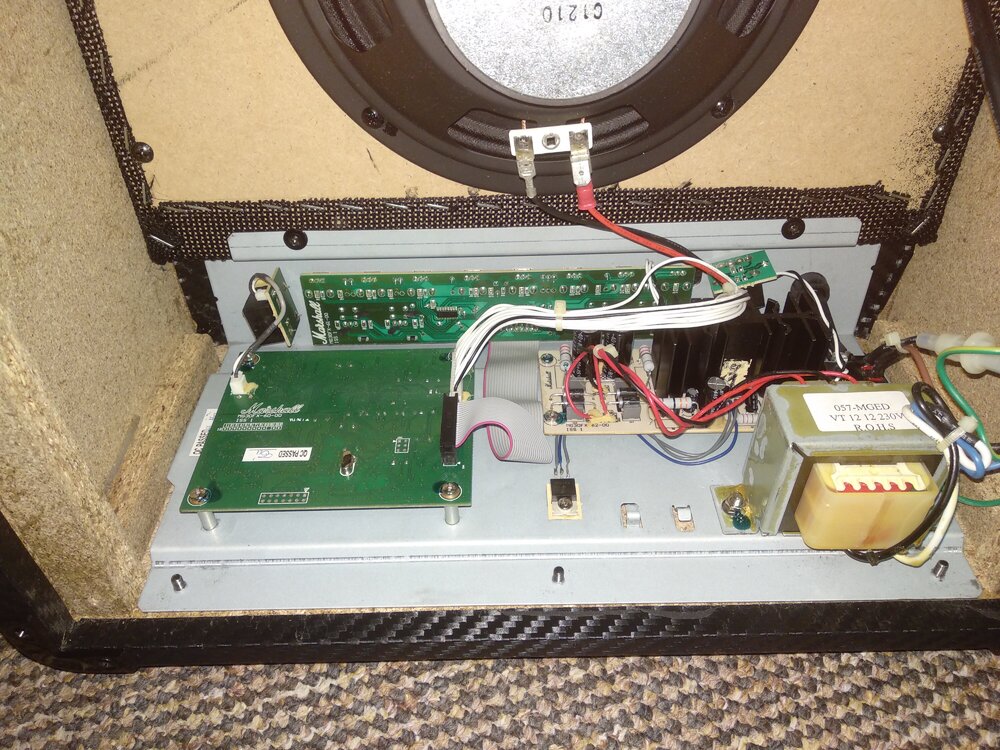Search the Community
Showing results for tags 'marshall'.
-
If your MG15CFX is suddenly dying after playing a while, this might be how to fix it. !!! WARNING !!! Guitar amplifiers contain high voltages and can cause injuries which are potentially lethal. Do not attempt repair work or modification if you are not a trained professional. The OP is not responsible for any damage or injury caused upon using the information provided. !!! YOU HAVE BEEN WARNED !!! Hi everyone, I have recently been working on a Marshall MG15CFX for a friend, quite a nice little practice amp. The issue was this - you would play the amp for a while, say 30 mins, and suddenly the sound dies and it goes really really quiet. After turning it off and on again, it would work again for a couple of minutes, until it goes dead quiet again. Sounds familiar? Well this might be of use to you. There seem to be some older posts in the Marshall forum that may (or may not) relate to this issue, but I didn't want to post there because of some of the things I am about to say about this product. Now, the case with the MG15CFX is this: the amp going quiet is actually the power stage going into thermal shutdown to protect itself from overheating; but let me take it from the top. I will explain a little bit the troubleshooting involved here so you can better test this yourself if you have one of those. The amp essentially consists of 3 main parts: i) the preamp, ii) the power amp and iii) the digital FX section. After playing the amp for a bit, when it eventually went quiet, I was still hearing a little bit of the guitar, with all the overdrive and the distortion form the preamp and FX section. This made me suspect that the problem lies with the power stage. Fortunately, the amp has a 3.5 mm Jack input for playback from an external device, so I hooked up my phone and played music through the amp until it eventually went quiet. Although the schematic for the amp isn't available anywhere, it is reasonable to assume that the playback input isn't connected to any of the FX or preamp circuitry, since it is unaffected by any of those settings (I tried to trace the tracks, but eventually got lost, but that doesn't matter for now anyway.) So this was a further hint at the power stage being the problem. After taking the amp apart and visual inspection, I found nothing obviously wrong, but the interesting bit is this: on the power board, the output transistor IC shares a heat sink with a linear voltage regulator. The voltage regulator supplies 5V to the digital circuitry in the FX section. But it's doing so by regulating 18V down as it's being supplied by the positive DC rail - If it's dropping 13V of course it gets hot pretty fast! And with the rather small heatsink and both ICs sitting back to back, of course the output transistor will go into thermal shutdown to protect itself. Technically, the output IC is exactly doing what it is supposed to in this scenario. So the amp is not as much broken as it has a fatal design flaw. Come on Marshall, you have clearly never tested this, this is very poor engineering. The way I fixed it: it's relatively straightforward, we just need to get rid of the heat and the problem shouldn't come back. Luckily, we have a very big heatsink at our disposal: the chassis itself. So I took out the voltage regulator (unscrew from heatsink, de-solder from PCB) and put it on the chassis instead. I was even able to repurpose the thermal pad still on the heatsink, you can remove it if you're careful with the right tool. Then connect wirs from the tabs of the voltage regulator back to the PCB (make sure to confirm which of it's legs is the input and which one is the output before you re-solder, these are the two legs on the outside, the middle one is ground) A photo is attached below, but I also recommend putting on some heatshrink to cover the exposed contacts on the regulator. After taking some measurements, the current draw seems to be about 100 mA, just to inform your choice of wire gauge. I have tested the amp for a continuous 90 mins of music playback at reasonable room volume (master around 9-10 o'clock) and the problem has not re-occured. It also didn't get nearly as hot anymore, both heatsinks are now doing their job, and so I assume it's fixed and works properly now. But yeah, the biggest disappointment is Marshall's engineering flaw embedded in this amp. It is a little surprising that no one caught on to this sooner and that they have been selling a product like this (I think it's discontinued now.)
- 2 replies
-
- 1
-

-
- marshall
- marshall amp
-
(and 2 more)
Tagged with:
-
Hi, anyone know much about the marshall jtm60 heads? As far as I know they were only produced for a year in '96 then were replaced by the jtm600s. Know they have overheating issues because of the tube alignment, but the one I'm looking at had a eletric fan installed. Anyone know what the tones like? Similar to a jtm45 sorta thing or completely different? Cheers.
-
Hi there! We completely gutted GH50L, then we put into it our preamp circuit, furthermore we brought in extra features: - presence control with selectable frequency - mid-shift - variable feedback - poweramp limiter - all tube footswitchable series FX loop with both send and return level adjustment Share Your thoughts PS. 100Hz HPF on guitar tracks, furthermore there's no eq changes. Raw samples recorded through 57/906 will come soon


.thumb.png.e19fa139483e0bb507cd7e19a7da06e2.png)